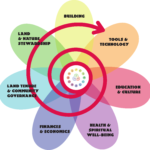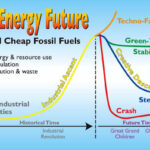A quick introduction to Permaculture
 Permaculture is a design system which can help us make more appropriate choices. Permaculture was conceived of in the 1970s by David Holmgren and Bill Mollison, and its ideas have now spread around the world. Its name comes from the idea of a PERMANENT human CULTURE (originally: Permanent + Agriculture = Permaculture).
Permaculture is a design system which can help us make more appropriate choices. Permaculture was conceived of in the 1970s by David Holmgren and Bill Mollison, and its ideas have now spread around the world. Its name comes from the idea of a PERMANENT human CULTURE (originally: Permanent + Agriculture = Permaculture).
Here are some places to learn about Permaculture quickly.
From the first time I heard about Permaculture, it simply made sense. I mean, why wouldn’t we design with a long-term view, for more-sustainable lifestyles? Why would someone design for anything else?
Permaculture ethics are at the core of the design system. Basically, you strive to balance the needs of people (Peoplecare), care for the earth (Earthcare), and reasonable distribution (Fair Shares) in any design you create.
Permaculture isn’t about abandoning one to promote another. For instance the tension between all three ethics in the system explains why a 4,000 sqft single family residence isn’t “sustainable” no matter how many solar panels or greywater showers it has – because it disregards Fair Shares. (A better solution is to pull sheer consumption back into something more appropriate for ecological footprint.)
- Here’s a brief explanation of Permaculture ethics by the Permaculture Association, and on David Holmgren’s website.

Permaculture Principles were created by David Holmgren to explain the philosophy.
To me, Permaculture Principles sometimes feel like they’re stating the obvious, like codifying pure common sense. Take “produce no waste” – I mean, why would someone design a system that knowingly creates waste? (Oh, wait: when money and profits are your objective instead of sustainability and planetary survival …)
The Permaculture Principles serve as a reminder of essential elements we want within a design. Some of these elements demand deeper study and introspection. For instance, I have had to learn tough lessons about “feedback loops.” Other Principles call us to quiet our mind and simply Observe what is.
- Here’s an infographic, and David Holmgren’s interactive website.

Permaculture isn’t just about designing farmland and buildings. It can inform and improve all aspects of our society – from the financial world to cultural messages we teach our children.

Here are great places to learn more:
- Permaculture, A Beginner’s Guide – excerpts from Graham Burnett’s booklet are free online as a pdf . These pages are an excellent overview that I often use with students.
- The Permaculture Flower described on David Holmgren’s website.
- a bit more about the history of Permaculture as the movement celebrates its 40th birthday
- To see Permaculture applied to aspects of life far beyond just land and buildings, look to the international Transition Movement, initiated by Rob Hopkins.
- To see Permaculture ideas applied to ways of organizing groups of people, see Starhawk’s excellent book, The Empowerment Manual.
- Here’s a much longer list of free Permaculture resources available on the internet.
Permaculture understanding has been the subtle backbone of everything I have done, from garden designs to event planning to novel writing. This gentle framework becomes like an ecosystem – the interrelated parts play together in ways you might never have expected. They help create something alive and resilient that can exceed your wildest dreams.


